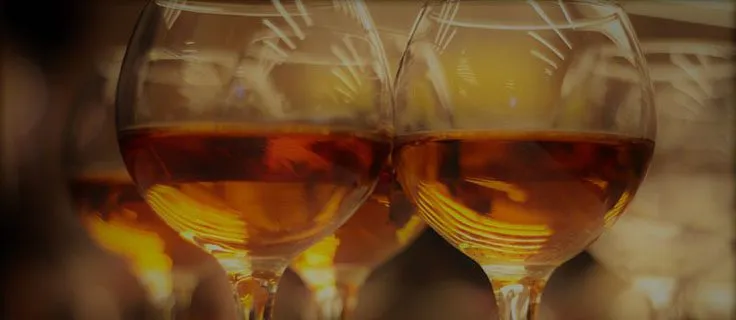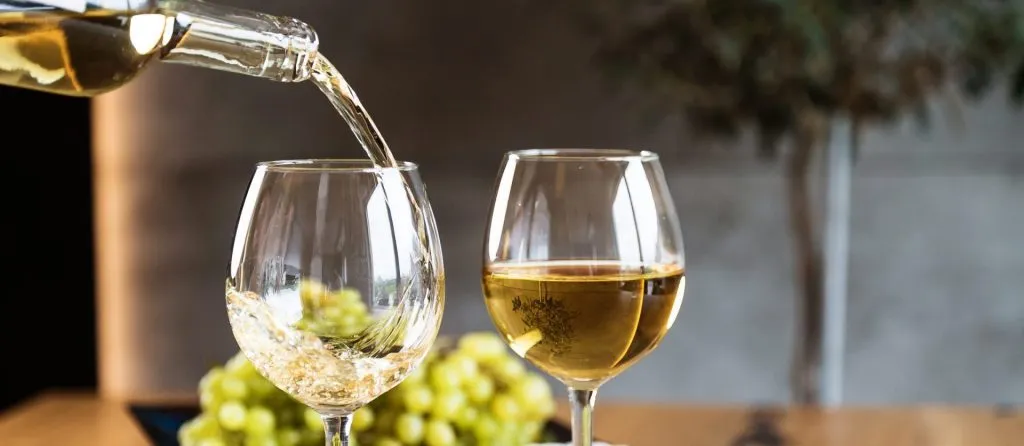Orange wine is not a rosé or wine made of oranges, as someone may think. It is in fact a white wine made with a process for red wines. Around the world, and even in Slovenia, this is actually an old process of producing white wines, although its global popularity among gourmets and wine experts has only flashed in the 90s. Apparently, it was named orange by an English sommelier, and in some parts of the world, it is also called amber wine because of its color. You can taste it at the Wine Tasting in Bled.
Orange wine is a white macerated wine. It is made of white grapes with maceration, a process for red wines. Maceration implies that during wine production the grape skin gets in contact with the must. Orange wines are characterized as robust and bold with honey flavors of tropical berry, hazelnut, Brazilian nuts, mature apples, linseed oil, juniper, sourdough and dried orange peel. On the palate, it is perceived as a dry wine as you can taste the tannins typical for red wines and the acidity of a fruit beer. Orange wine is often so intense that it is advisable to sit down when tasting your first sip.
“The history of orange wines takes place in the times of our grandfathers, especially in the Primorska region where mostly white wines were produced while the modern winemakers started to professionally produce it in the 90s. Today, many winemakers produce orange wines in all three of our wine-growing regions. Among the orange pioneers are certainly the Slovenians in Italy Joško Gravner and Stanislav Radikon and Valter Mlečnik from the Vipava valley. Today we find winemakers who produce orange wines in all three Slovenian wine-growing regions (Primorska, Posavje, and Podravje), “explains the sommelier. First orange wines were drunk 6,000 years ago in the Caucasus, in the area of today’s Georgia, in Asia Minor, and in the Balkans. The revival of this ancient process of orange wine production has occurred in the last twenty years. Many modern ‘orange’ vine growers in the area of today’s Georgia ferment wine in large underground vessels, called Qvevri, which were originally sealed with stones and beeswax.
“It is a mistake to believe that orange wines are the recent years’ trend since the cultivation of orange wines in Slovenia is a tradition and not just a trend. For true connoisseurs, a glass of orange wine has been popular for a long time, although the orange trend has only been around in recent years. The regions where orange wines are a tradition are Slovenia, Croatia, Istria, and Italy, and are a trend in Austria, Germany, France, the Czech Republic, Australia, the United States, and New Zealand. If you choose Wine Tasting Ljubljana, you will taste also our orange wine and other six Slovenian wines,” explains our sommelier Boris Vukobrat.
The sommeliers serve orange wines slightly warmer than a classic white, and slightly cooler than a red. The best temperature is around 12ºC. It’s also perfectly acceptable to drink them slightly cooler, around 10ºC degrees, if it’s hot outside and you want them to be very refreshing. Because of their boldness, orange wines pair excellently well with equally bold foods, including curry dishes, Moroccan cuisine, Ethiopian cuisine, Korean dishes with fermented kimchi, and traditional Japanese cuisine, including fermented soybeans. Due to the high phenolic content (tannin and bitterness) and the nutty tartness they exhibit, orange wines pair with a wide variety of meats, ranging from beef to fish.









